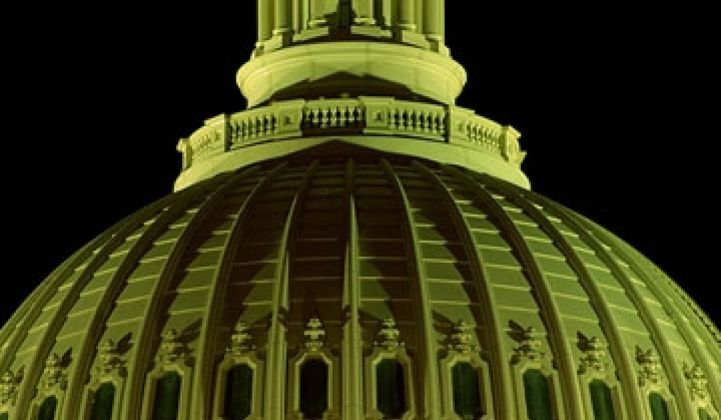President Obama issued an executive order last October requiring every government agency to spell out how it plans to "lead by example" in environmental sustainability. He wanted to hear about waste management and water use, smart meters in federal office buildings and alternative-fuel vehicles in public fleets.
The Strategic Sustainability Performance Plans were finally due last week, and embedded in the dense documents -- no one should print these things, even on recycled paper -- are hundreds of seemingly small ideas. The relatively obscure Corporation for National and Community Service, for one, is promising to set all of its printers to double-sided default mode and to check the tire pressure every time a government vehicle leaves the lot.
The federal government is the largest consumer of energy in the U.S. economy, and the president is aiming for a 28 percent reduction in direct greenhouse gas pollution by 2020. But will all the ideas add up? Here's a look at what many departments have in mind.
1. The U.S. Department of Agriculture used an estimated 1.737 billion gallons of water in its buildings during fiscal year 2009, all of which cost about $8.1 million (the president also wants taxpayers save money while the government is at it conserving energy). The USDA has actually cut its water consumption since 2007 by about 20 percent, and it hopes to wring future savings through new water meters, better rainfall management and using native plant species in landscaping.
2. Inside the Department of Defense, the Air Force is planning to certify (click here for PDF) all of its aircraft against a 50-50 alternative fuel blend by 2011, and by 2016, the Navy expects to field a carrier strike group of nuclear vessels and ships powered by biofuel. Permanent military installations are also already generating their own renewable energy. Nellis Air Force Base in Nevada has 72,000 solar panels producing 30 million kilowatt-hours of electricity per year.
3. The Department of Education is planning to cut down on the physical paperwork most college students know well -- federal student loan applications. The program will be administered almost entirely online, saving both paper and the energy required to transport it. The Department also anticipates that as it brings on about 500 new full-time employees, it will find new ways to put them to work, either through satellite offices or telecommuting.
4. The Department of Energy squats in about 10,000 buildings and trailers across the country, covering more than 126 million square feet of office space, warehouses and laboratories. As the DOE builds more modern facilities, it will adhere to a "one-for-one" policy: For every square foot of new construction, one square foot of similar building must be decommissioned and disposed of. At the beginning of this fiscal year, the Department also generated 0.16 percent of its power from on-site renewables. That figure should reach 5.1 percent by the end of fiscal year 2012.
5. The Department of Interior has a similarly expansive footprint: It manages 20 percent of the country's land, while operating 47,000 buildings and 33,000 vehicles. It wants all of its new buildings by the end of 2030 to achieve net-zero energy (i.e., generating as much as they consume). Among programs already underway, Zion National Park is phasing out the sale of water bottles in favor of reusable "bottle filling stations" (water fountains?). And a new 18-kilowatt photovoltaic system will offset 30 percent of the electricity used at the Grand Canyon's South Rim visitor center.
6. The Department of Housing and Urban Development is giving energy retrofits to 126,000 public-housing units in 2010 and 2011. The Department is spending about one-third of is $4.86 billion in Recovery Act funds on "greening" public housing stock. Inside its own offices, HUD has also nearly doubled its monthly employee transit subsidy (now $230). Seventy-six percent of employees at the department's headquarters now commute to work by transit.
7. The Department of State admits to a unique problem: "The concept of effective diplomacy is inherently about people-to-people relationships and contacts" -- in other words, long-distance travel. Last year, State bought 142,370 tickets for domestic travel, producing more than 92 million pounds of greenhouse gases. To get around some of that pollution, the Department plans to look at alternatives in digital video and Web conferencing, in the process scrutinizing "one of the Department's fundamental business models."
8. A slew of Environmental Protection Agency offices have sprouted green roofs, including a laboratory in Rhode Island, an annex in Cincinnati, regional offices in Denver, Seattle, Boston and a headquarters satellite in Arlington, Va. The EPA also has its first carbon-neutral laboratory building in Oklahoma and an all-electric office in Kansas City, Kan.
9. The Peace Corps is reducing the square footage -- and associated energy use -- at its headquarters by 10 percent through more efficient space design. And it has cut down on electricity consumption by 16 percent at the Washington headquarters by shutting down HVAC systems on weekends and holidays.
10. The Army Corps of Engineers is renovating two office spaces in Seattle to use eco-friendly carpeting, furniture and countertops. The Louisville District plans to replace 21 non-hybrid government vehicles with new energy-efficient ones. And the Sacramento District is placing solar electric systems on nine dams, where they're expected to satisfy about 40 percent of each office's electricity needs.



